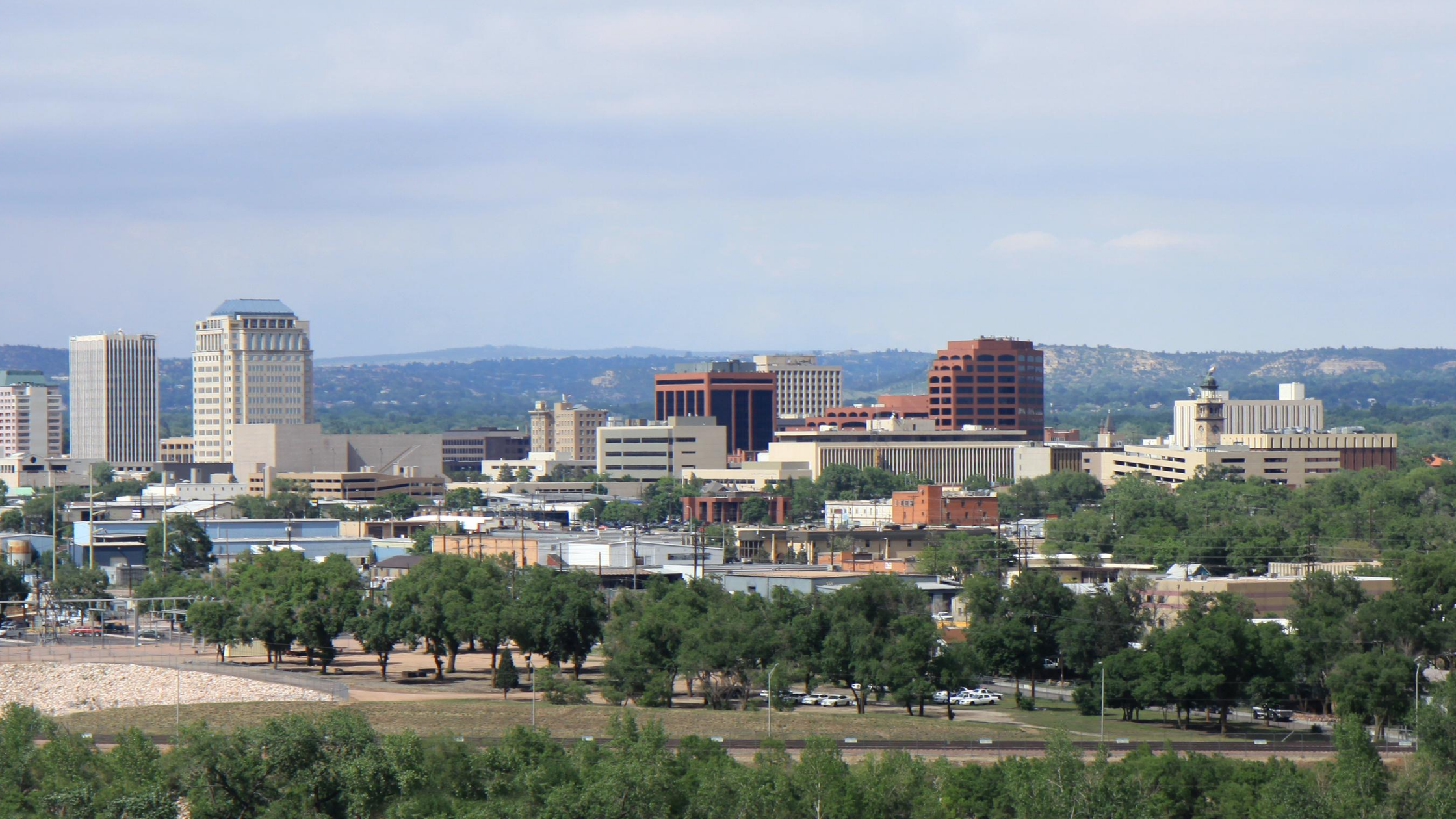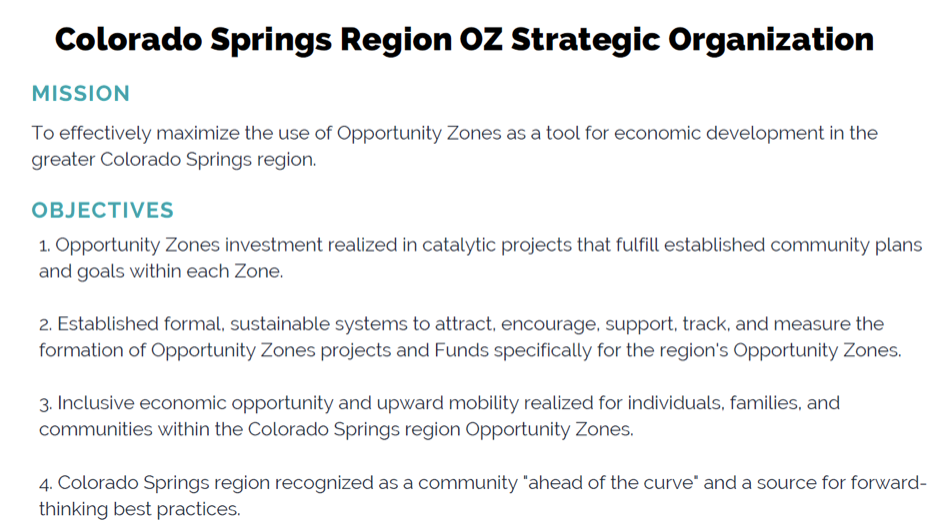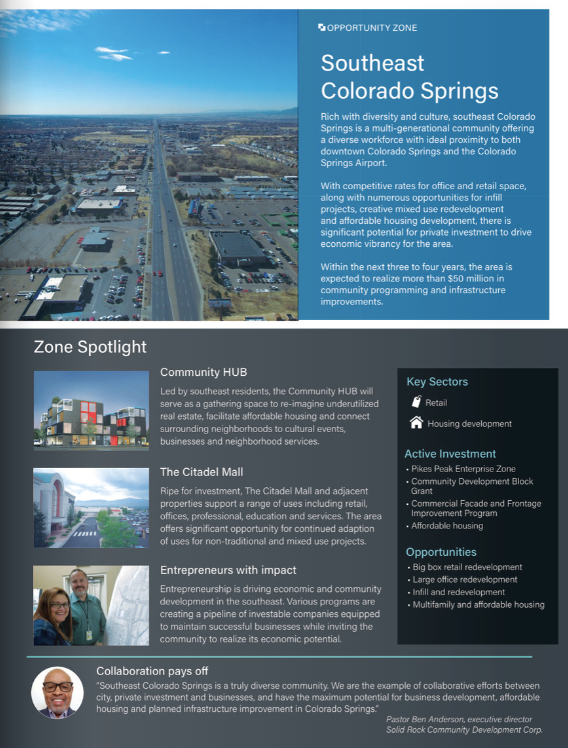
This article is written by Chelsea Gaylord, Senior Economic Development Specialist, City of Colorado Springs. Chelsea wrote this article as part of the Equity Ambassadors Cohort. You can find all the articles for this cohort here.
For 2.5 hours, Colorado Springs’ nine city council members grilled representatives of a proposed 427-unit housing development in Southeast Colorado Springs. The project was being considered for some of the only developable land inside its federally designated Opportunity Zone but not actually using the Opportunity Zone tool. Council wanted to understand whether the project still met the goals for Southeast’s revitalization.
As the City of Colorado Springs’ lead for Opportunity Zones, the City Council session posed the critical question that I work on every day and one that is playing out in over 8,700 Opportunity Zones across the country: How do we effectively maximize private investment in a way that ensures inclusive opportunity and upward mobility for individuals, families, and the communities living in these areas?
What is an Opportunity Zone?
Created as part of the 2017 Tax Cuts and Jobs Act, Opportunity Zones were designed to encourage long-term, private investment in low-income communities that have historically been ignored. Investors who put their money into these designated areas can receive deferral, reduction, and elimination of their capital gains taxes for investments in job creation, housing development, and economic growth in communities that are among the highest-need and most diverse across the nation.
The question of ensuring investment that promotes shared prosperity is even more urgent as urban and rural communities across the nation are left reeling from the health, economic, and social crises of the Covid-19 global pandemic. The national protests following the death of George Floyd and critiques of the federal CARES Act relief funds have further amplified existing gaps in unequal access to capital for businesses, wealth creation, and quality of life for people of color and low-income families. Addressing long-existing, systemic inequities will require community-informed efforts that use economic development tools to improve access to capital for projects and businesses in our low-income communities and fuel their recovery.
Many of these hardest hit communities are located in designated Opportunity Zones, making the incentive uniquely positioned as a tool for equitable recovery. The success of this requires attention to existing community assets, needs and priorities of residents living in these communities, and investor interests. It also rides on inclusive and transparent outreach and purposeful efforts to avoid unintended consequences including displacement of community members. Over the last 2.5 years since Opportunity Zones were created, my work, in collaboration with community partners, has been focused on leveraging this tool for catalytic investments that are informed by community voices and meet our region’s goals. The following is a highlight of those efforts, which we are now building from as we think about Opportunity Zones as one of our tools for Covid-19 recovery.
Collaboration with representation
We have eight Opportunity Zones that are located across Colorado Springs, El Paso County, and City of Fountain jurisdictions.
With such a large area and population to represent, we quickly brought together a collaborative network of economic and community development partners and stakeholders in each zone to form a “strategic team.” This team, made up of organizations such as the Chamber & EDC, Downtown Partnership, Urban Renewal Authority, Colorado Springs Utilities, a grassroots community development corporation, and city and county organizations, inform our regional strategy, a unified message around our Opportunity Zones, and allows us to quickly connect a project or investor to the right resources. With this team, we co-created a strategic organization with a mission and objectives for our efforts.

The strategic objectives for the Greater Colorado Springs Region’s Opportunity Zones
To make sure each zone’s perspective and authentic voice is represented, we also designated “Opportunity Zone Captains.” Captains are subject matter experts in Opportunity Zones, and work and/or live in their zone. While the pandemic put our strategic efforts on temporary hold, the goal is to have these captains assist with community outreach and education, to identify potential projects, and help us spread the word about Opportunity Zone-related initiatives.
Market your values
While regulations were still being developed, at the advice of national thought leaders, we began developing an Opportunity Zone Investment Prospectus to highlight our assets and high-priority projects.
Pulling together representatives from the Black Chamber, Better Business Bureau, public health, Opportunity Zone residents, accountants, developers, and investors, we convened a “Prospectus Design Team” to inform our work. This early effort not only made us one of the first twenty communities in the entire U.S. to develop a prospectus, it ensured that the content spoke to the community’s value on social impact, collaboration, and innovation.
The layout and style were also the first of its kind and reflects an important human-centred design, highlighting our community’s diverse leadership and the faces behind our high-impact efforts.

Opportunity Zone investment prospectus spotlight, Southeast Colorado Springs
Leveraging federal funding for priority projects
City governments are uniquely positioned to pursue federal grants and programs to leverage public resources, gather community input, and spur private investment toward priority projects.
With the creation of the White House Opportunity and Revitalisation Council to align federal programs with Opportunity Zones, projects in these zones now have greater opportunities to receive federal funding.
In 2019, we received an EPA Brownfields Assessment Coalition Grant for environmental assessments that will encourage development in a four mile corridor that runs through the heart of Colorado Springs, into the City of Fountain, and through two of our Opportunity Zones. The funding helps us build off a multi-year master planning effort that captured the imaginations of our residents, and a key focus of our initial grant efforts has been on developing a public involvement plan, advisory committee, and accessible information materials.
This intentional engagement ensures that residents are part of the redevelopment of the corridor in a way traditional private development doesn’t include.
Measure what matters
To understand the impact of investments and whether you’re moving the needle on community priorities, measurement matters.
To date, reporting requirements in Opportunity Zones’ federal regulations are limited. It is up to communities to identify key metrics and ensure alignment on metrics and desired results for investments in their zones. I’ve used the Opportunity360 Community Dashboard to set a baseline of key metrics like economic security, housing stability, and health and well-being in each of our zones and can track outcome index scores over time to demonstrate impact.
Local governments can also use the Opportunity Zone Reporting Framework to measure types of investment, level of community engagement with individual projects, and project impacts such as the number of new jobs created or new affordable housing units constructed to ensure projects are in alignment with community priorities.
Meeting the Covid-19 moment
Covid-19 and the Black Lives Matter movement have created an opportunity for cities to take a harder look at themselves, ask new questions, and re-assess community needs. Colorado Springs is re-examining an expansive list of needs and priorities from business re-openings and workforce development to infrastructure and affordable housing.
Our same Opportunity Zone strategic team partners are collecting survey information on industry impacts, assessing business needs as we look towards colder months, and discussing diversity, equity, and inclusion as key components of our recovery strategy. Opportunity Zones are only one tool available in our pursuit of equitable economic recovery, but we are exploring how to use this incentive as a framework for conversations around capital access for entrepreneurs, investor priorities, and enhanced community involvement in redevelopment projects.
It was early 2020 when the housing project came in front of City Council, just months away from when we planned to launch a strategic planning and community outreach effort around our Opportunity Zones that was derailed due to the pandemic. While projects are not required to utilize Opportunity Zones, some city council and community members were concerned the housing project didn’t meet their vision of a gathering space that would reflect the culture and diversity of the community and that approval meant a loss of 66% of their available Opportunity Zone land.
Having sat vacant for several years, others saw the project as the only available option for much-needed, long-awaited investment regardless of whether the Opportunity Zone incentive was used.
The conversation at council and the crises our community is now facing make our plans for community-informed development even more important to ensure inclusive recovery and a shared vision of prosperity for residents and investors. We aren’t perfect, and we still have a lot of work to do around diversity, equity, and inclusion across the entirety of our economic development work.
To truly rebuild better will require intentional, creative adaptation of every tool and effort to ensure that we emerge from Covid-19 with a stronger, more equitable system for community investment and development.
